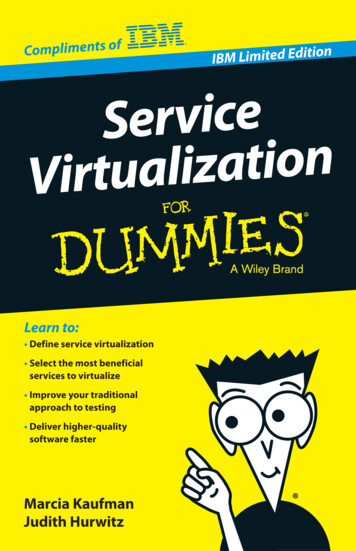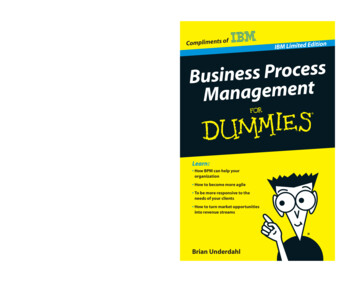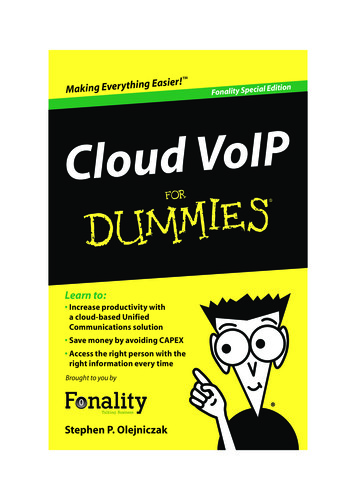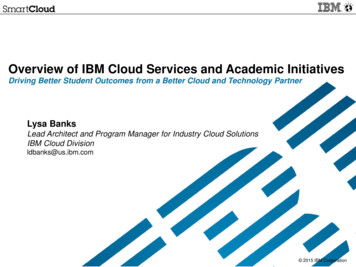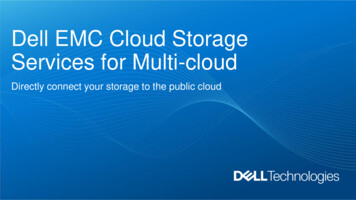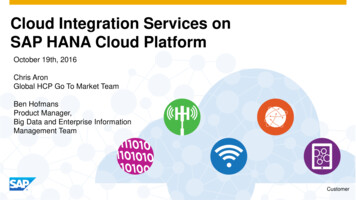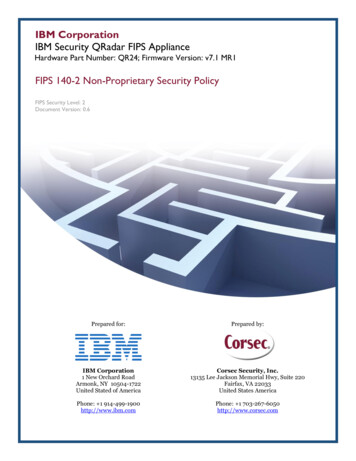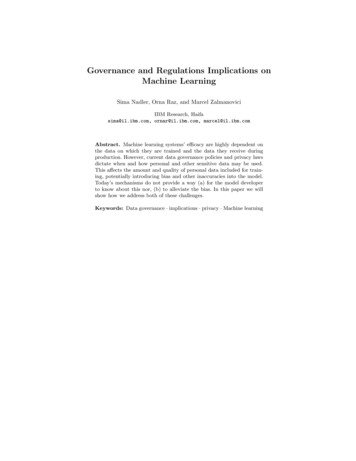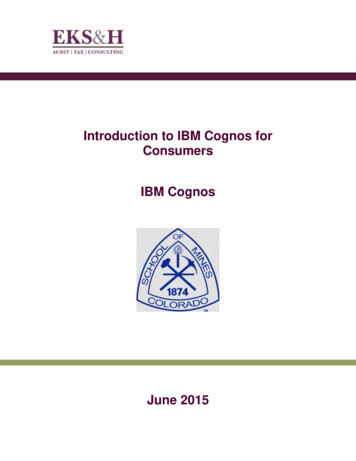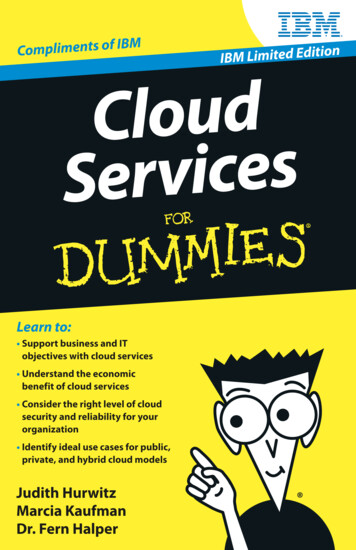
Transcription
CloudServicesFORDUMmIES‰IBM LIMITED EDITIONby Judith Hurwitz,Marcia Kaufman, andDr. Fern HalperThese materials are the copyright of John Wiley & Sons, Inc. and anydissemination, distribution, or unauthorized use is strictly prohibited.
Cloud Services For Dummies , IBM Limited EditionPublished byJohn Wiley & Sons, Inc.111 River StreetHoboken, NJ 07030-5774www.wiley.comCopyright 2012 by John Wiley & Sons, Inc., Hoboken, New JerseyPublished by John Wiley & Sons, Inc., Hoboken, New JerseyNo part of this publication may be reproduced, stored in a retrieval system or transmitted in anyform or by any means, electronic, mechanical, photocopying, recording, scanning or otherwise,except as permitted under Sections 107 or 108 of the 1976 United States Copyright Act, without theprior written permission of the Publisher. Requests to the Publisher for permission should beaddressed to the Permissions Department, John Wiley & Sons, Inc., 111 River Street, Hoboken, NJ07030, (201) 748-6011, fax (201) 748-6008, or online at http://www.wiley.com/go/permissions.Trademarks: Wiley, the Wiley logo, For Dummies, the Dummies Man logo, A Reference for the Restof Us!, The Dummies Way, Dummies.com, Making Everything Easier, and related trade dress aretrademarks or registered trademarks of John Wiley & Sons, Inc. and/or its affiliates in the UnitedStates and other countries, and may not be used without written permission. IBM and the IBM logoare registered trademarks of IBM. All other trademarks are the property of their respective owners.John Wiley & Sons, Inc., is not associated with any product or vendor mentioned in this book.LIMIT OF LIABILITY/DISCLAIMER OF WARRANTY: THE PUBLISHER AND THE AUTHOR MAKENO REPRESENTATIONS OR WARRANTIES WITH RESPECT TO THE ACCURACY ORCOMPLETENESS OF THE CONTENTS OF THIS WORK AND SPECIFICALLY DISCLAIM ALLWARRANTIES, INCLUDING WITHOUT LIMITATION WARRANTIES OF FITNESS FOR APARTICULAR PURPOSE. NO WARRANTY MAY BE CREATED OR EXTENDED BY SALES ORPROMOTIONAL MATERIALS. THE ADVICE AND STRATEGIES CONTAINED HEREIN MAY NOT BESUITABLE FOR EVERY SITUATION. THIS WORK IS SOLD WITH THE UNDERSTANDING THATTHE PUBLISHER IS NOT ENGAGED IN RENDERING LEGAL, ACCOUNTING, OR OTHERPROFESSIONAL SERVICES. IF PROFESSIONAL ASSISTANCE IS REQUIRED, THE SERVICES OF ACOMPETENT PROFESSIONAL PERSON SHOULD BE SOUGHT. NEITHER THE PUBLISHER NORTHE AUTHOR SHALL BE LIABLE FOR DAMAGES ARISING HEREFROM. THE FACT THAT ANORGANIZATION OR WEBSITE IS REFERRED TO IN THIS WORK AS A CITATION AND/OR APOTENTIAL SOURCE OF FURTHER INFORMATION DOES NOT MEAN THAT THE AUTHOR ORTHE PUBLISHER ENDORSES THE INFORMATION THE ORGANIZATION OR WEBSITE MAYPROVIDE OR RECOMMENDATIONS IT MAY MAKE. FURTHER, READERS SHOULD BE AWARETHAT INTERNET WEBSITES LISTED IN THIS WORK MAY HAVE CHANGED OR DISAPPEAREDBETWEEN WHEN THIS WORK WAS WRITTEN AND WHEN IT IS READ.For general information on our other products and services, please contact ourBusiness Development Department in the U.S. at 317-572-3205. For details on how tocreate a custom For Dummies book for your business or organization, contact info@dummies.biz. For information about licensing the For Dummies brand for products orservices, contact BrandedRights&Licenses@Wiley.com.ISBN: 978-1-118-33891-9 (pbk) 978-1-118-34012-7 (ebk)Manufactured in the United States of America10 9 8 7 6 5 4 3 2 1These materials are the copyright of John Wiley & Sons, Inc. and anydissemination, distribution, or unauthorized use is strictly prohibited.
Table of ContentsIntroduction . . . . . . . . . . . . . . . . . . . . . . . . . . . . . . . . . . . . . . 1About This Book. 2Foolish Assumptions. 2How This Book Is Organized. 3Icons Used in This Book. 4Chapter 1: Understanding Cloud Fundamentalsand the Cloud Continuum . . . . . . . . . . . . . . . . . . . . . . . . 5Discovering Cloud Basics. 6Foundational Cloud Delivery Services. 6Core Cloud Capabilities. 8Elasticity and self-service provisioning. 8Billing and metering of service usage. 9Workload management. 9Management services. 9Understanding the Cloud Continuum. 10Open community clouds. 12Controlled open mode. 12Contractual open. 13Public/private hybrid clouds. 13Chapter 2: Digging Deeper into IaaS and PaaS. . . . . . . 15Diving into Infrastructure as a Service. 16Listing the characteristics of IaaS. 16Renting. 17Self-service provisioning. 17Dynamic scaling. 17Service levels. 17Licensing. 18Metering. 18Considering a private IaaS. 18Knowing how companies use IaaS. 19Exploring PaaS. 20Variations in PaaS delivery models. 21Understanding the benefits of PaaS. 22Having the Correct Requirements for IaaS and PaaS. 23These materials are the copyright of John Wiley & Sons, Inc. and anydissemination, distribution, or unauthorized use is strictly prohibited.
ivCloud Services For Dummies, IBM Limited EditionChapter 3: Diving into Cloud Economics. . . . . . . . . . . . . 25Developing an Economic Strategy. 26Comparing traditional models with the cloud. 26Finding the value. 27Exploring the Costs. 29What you save or gain with cloud services. 32Cost calculating. 32Assessing workloads. 33Using a cost estimator tool. 33Chapter 4: Managing Cloud Workloadsand Services . . . . . . . . . . . . . . . . . . . . . . . . . . . . . . . . . . 35Understanding Workloads. 36Looking at Workload Use Cases. 37Analytics workload. 37Batch workloads. 38Looking at the Principles of Workload Management. 39Seeing Workload Management in a Hybrid Cloud. 39Connecting Workloads in the Cloud. 40The importance of APIs. 41A standard workload layer. 41Portability of workloads. 42Managing and Monitoring Workloads. 42Tracking workloads. 43Asking the right questions. 43Chapter 5: Improving Security, Governance,and Cloud Reliability . . . . . . . . . . . . . . . . . . . . . . . . . . . 45Finding out Why Cloud Security Matters. 45Establishing a Cloud Governance Strategy. 48Governance issues in the cloud. 48Risks worth noting. 49Making cloud governance work. 50Managing Service Levels. 50Developing a Secure, Accountable, andReliable Cloud Environment. 52Assessing your current state. 53Implementing security best practices. 54These materials are the copyright of John Wiley & Sons, Inc. and anydissemination, distribution, or unauthorized use is strictly prohibited.
Table of ContentsChapter 6: Starting Your Cloud Journey . . . . . . . . . . . . . 55Integrating Your Business, IT, and Cloud Strategies. 56Getting Started with IaaS and PaaS. 57Private IaaS for development and test. 57Public IaaS for development and test. 57Public PaaS for architecting new business models. 58Private PaaS for delivering new services. 58Accelerating the Company’s Momentum. 58Gaining IT acceptance. 59Managing cloud services. 59Planning the Successful Journey. 60Business considerations. 61How’s the business changing?. 61How does the company want toprovide services in the future?. 61What are the financial constraintsfor the company?. 62Is the company too siloed for the strategy?. 62Is there an easy mechanism to encourageexperimentation and innovation?. 62Implementation considerations. 62Evaluating reference architectures. 62Focusing on efficiency and flexibility. 63Planning for a fabric of services. 63Assuming that you’ll plan fora lightweight approach. 63Monitored and managing everything you do. 63Transforming IT with Cloud. 63These materials are the copyright of John Wiley & Sons, Inc. and anydissemination, distribution, or unauthorized use is strictly prohibited.v
IntroductionWelcome to Cloud Services For Dummies, IBM LimitedEdition. Whether public, private, or hybrid, cloudcomputing is becoming an increasingly integral part of manycompanies’ business and technology strategy. Cloud serviceshelp companies turn IT resources into a flexible, elastic, andself-service set of resources that they can more easily manageand scale to support changing business needs.While many different delivery models for cloud computingservices exist, two foundational services are a requirementfor making cloud computing into a strategic part of an overallcomputing infrastructure. These include Infrastructure as aService (IaaS) and Platform as a Service (PaaS). IaaS is theservices that enable you to gain access to compute and storageresources in an on demand model. PaaS is the services that siton top of IaaS and enable you to build applications to supportthe business.No matter what your plan for your evolving IT infrastructuremay be, you can take advantage of these services in combinationwith on-premises platforms to create flexibility for the business.Cloud computing serves different needs for different constituentswithin your organization. For business leaders, cloud computingis a cost-effective way to leverage IT resources to prototypeand implement strategic change. For your IT organization,the cloud is a platform that allows it to be significantly moreproactive and responsive when it comes to supportingstrategic business imperatives. While IT is leading the chargein focusing on best practices that support the balanced useof public, private, and data center resources — the emergingworld of hybrid computing — don’t lose sight of the fact thatcloud is just as much about business model transformationas it is about technology transformation. In fact, manycompanies find that the cloud helps to support increasedcollaboration between business and IT leaders enabling themto more quickly adjust to changing market dynamics.These materials are the copyright of John Wiley & Sons, Inc. and anydissemination, distribution, or unauthorized use is strictly prohibited.
2Cloud Services For Dummies, IBM Limited EditionAbout This BookThis book gives you some insights into what it means toleverage both IaaS and PaaS in both public and private cloudenvironments and how these environments work with datacenter services. Companies leveraging these foundationalcloud services need to keep all the models in context withbusiness requirements for performance, security, andportability.This book helps put the foundational cloud services — IaaSand PaaS into context. In addition, the topics covered in thisbook are critical to the success of hybrid environments.Foolish AssumptionsThis book is useful to many people, but we have to admit thatwe did pick a segment of the world to focus on. Here’s who wethink you are: You’re already using various forms of cloud computingand are planning a long-term strategy. Perhaps we’repreaching to the choir. You understand that the benefitsof using all kinds of flexible cloud computing modelsrepresent sources of sustainable competitive advantage. You’re a business leader who wants IT resources to be autility that’s optimized to leverage what you’ve alreadypaid for. You want IT to serve your business needs —you want to be able to execute your strategy on yourtimetable. You want IT to be your partner in innovatingfor the future. You’re an IT leader who knows a lot about technologybut aren’t sure precisely how cloud computing — public,private, or a combination of the two as a hybrid model —works. You need to understand how cloud computingchanges IT and what you need to do to support thebusiness with cloud computing as an important enabler.These materials are the copyright of John Wiley & Sons, Inc. and anydissemination, distribution, or unauthorized use is strictly prohibited.
Introduction3How This Book Is OrganizedThis book isn’t intended to be an exhaustive technical manualon implementing and managing cloud computing. Instead, wegive you a taste of the concepts and approaches you needto consider when embarking on your journey to the hybridcloud.We’ve organized this book into six chapters: Chapter 1 gives you an overview of the business casefor foundational cloud services — what it means to thebusiness and how these services support the overall ITapproach. Chapter 2 provides you with an understanding of thetechnical foundation for IaaS and PaaS. The chapterincludes use cases that explain the business benefits tothe organization. Chapter 3 delves into the economics of cloud services.The chapter explains the type of economic benefit yougain from using foundational cloud services and howthey support changing business requirements. Chapter 4 provides an overview of managing cloudworkloads and services. Many different types of workloadsneed to be supported in the cloud. This chapter presentsthe different workloads and how they need to be managedto support IT and business needs. Chapter 5 provides insights into the important issue ofsecurity, governance, and cloud reliability. What does itmean to have a secure cloud and how do you ensure thatyour assets are safe? How do you have the right level ofsupport for governance rules that keeps your companysafe and in compliance? Chapter 6 gives you a roadmap for planning your journeyto the hybrid cloud from a best practices perspective.These materials are the copyright of John Wiley & Sons, Inc. and anydissemination, distribution, or unauthorized use is strictly prohibited.
4Cloud Services For Dummies, IBM Limited EditionIcons Used in This BookThe following icons are used to point out important informationthroughout the book:Tips help identify information that needs special attention.Pay attention to these common pitfalls of managing yourfoundational cloud.This icon highlights important information that you shouldremember.This icon contains tidbits for the more technically inclined.These materials are the copyright of John Wiley & Sons, Inc. and anydissemination, distribution, or unauthorized use is strictly prohibited.
Chapter 1Understanding CloudFundamentals and theCloud ContinuumIn This Chapter Understanding the essentials of cloud computing Exploring the cloud continuum Examining foundational delivery servicesHow quickly things change. Cloud computing has evolvedfrom a risky and confusing concept to a strategy thatorganizations large and small are beginning to adopt as partof their overall computing strategy. Companies are nowstarting to ask not whether they should think about cloudcomputing but what types of cloud computing models arebest suited to solve their business problems. Not only areorganizations using the cloud for services such as e-mailor customer relationship management, but also many areutilizing a set of important cloud foundational services —Infrastructure as a Service (IaaS) and Platform as a Service(PaaS) — to develop and deploy applications to support thebusiness and open up new innovative opportunities and newrevenue streams.The kind of cloud deployment you should consider dependson your own particular performance, security requirements,and your specific business goals. In this chapter, you look atthe fundamentals of cloud computing and the insights intothe range of cloud services and models that you need tounderstand. It’s important to understand that there’s aThese materials are the copyright of John Wiley & Sons, Inc. and anydissemination, distribution, or unauthorized use is strictly prohibited.
6Cloud Services For Dummies, IBM Limited Editioncontinuum of cloud services. These services range from anopen and shared public environment to private cloud that’stightly managed with the highest level of security and service.You also discover two key foundational cloud deliverymodels: IaaS and PaaS. In addition, Software as a Service(SaaS) provides packaged business process offerings that livein the cloud and leverage both IaaS and PaaS services.Discovering Cloud BasicsCloud computing is a method of providing a set of sharedcomputing resources that includes applications, computing,storage, networking, development, and deployment platformsas well as business processes. Cloud computing turns traditionalsiloed computing assets into shared pools of resources thatare based on an underlying Internet foundation.Clouds come in different versions, depending on your needs.There are two primary deployment models of cloud: publicand private. Most organizations use a combination of privatecomputing resources (data centers and private clouds) andpublic services as a hybrid environment. These clouds arecovered in more detail throughout this chapter.The cloud doesn’t exist in isolation to other corporate ITinvestments. The reality is that most companies use acombination of public and private cloud services in conjunctionwith their data center. Companies use different methods,depending on their business requirements to link andintegrate these services. The way you construct your hybridcomputing environment is determined by the complexity ofthe workloads and how you want to optimize the performanceof those workloads to support your constituents.Foundational CloudDelivery ServicesUnderstanding the foundations of cloud computing calls forunderstanding three main cloud delivery models:These materials are the copyright of John Wiley & Sons, Inc. and anydissemination, distribution, or unauthorized use is strictly prohibited.
Chapter 1: Understanding Cloud Fundamentals and the Cloud Continuum7 IaaS: The delivery of services such as hardware, software,storage, networking, data center space, and variousutility software elements on request. Both public andprivate versions of IaaS exist. In the public IaaS, the user needs a simple sign-upmechanism to acquire resources. When users nolonger need the resources, they simply de-provisionthem. In a private IaaS, the IT organization or an integratorcreates an infrastructure designed to provideresources on demand to internal users andsometimes partners. IaaS is the fundamental elementused by other cloud models. Some customers bringtheir own tools and software to create applications. PaaS: A mechanism for combining IaaS with an abstractedset of middleware services, software development, anddeployment tools that allow the organization to have aconsistent way to create and deploy applications on acloud or on-premises environment. A PaaS environmentsupports coordination between the developer and theoperations organization, typically called DevOps. A PaaSoffers a consistent set of programming and middlewareservices that ensure developers have a well-tested andwell-integrated way to create applications in a cloudenvironment. A PaaS requires an infrastructure service. SaaS: A business application created and hosted by aprovider in a multi-tenant (shared) model. The SaaSapplication sits on top of both a PaaS and foundationalIaaS. In fact, a SaaS environment can be built directlyon an IaaS platform. Typically these underlying servicesaren’t visible to end-users of a SaaS application.A hybrid cloud combines private cloud services with publiccloud services where one or several touch points are betweenthe environments. What does this mean? If a few developersin a company use a public cloud service to prototype a newapplication that’s completely disconnected from the privatecloud or the data center, the company doesn’t have a hybridThese materials are the copyright of John Wiley & Sons, Inc. and anydissemination, distribution, or unauthorized use is strictly prohibited.
8Cloud Services For Dummies, IBM Limited Editionenvironment. On the other hand, a cloud is hybrid when acompany uses public cloud services for tasks such asprototyping or testing a new application. When the applicationis completed it may be moved to the private cloud. In anothersituation, the Web servers are on a public cloud service that’sintegrated with payment systems that are run in a privatecloud.A company with a private cloud may choose to combine somepublic services for capabilities that are commodities withprivate services based on the ability to deliver fast innovationto their ecosystem. For example, companies are increasinglydiscovering that it’s practical to pay a per-user, per-yearprice for customer relationship management (CRM) and leavethe day-to-day management to a trusted vendor. But manycompanies also want to keep control over some of their mostsensitive data. Therefore, they may choose to keep data aboutprospects on a public cloud. However, after those prospectsbecome customers, the companies may begin storing thatdata on their own premises in their own servers, which is thehybrid cloud model.Core Cloud CapabilitiesRegardless of the model that you use, some core capabilitiesthat are essential in the cloud environment include the areascovered in this section.Elasticity and self-serviceprovisioningA key feature of a cloud environment is that it provides aplatform that’s designed to be elastic (you can use just theresources you want when you need them), so the users/customers provision resources, such as computing or storageresources, that they pay for on a per-unit basis. When the userno longer needs that resource and stops paying, the resourceis released back into the pool of resources. This helpsorganizations avoid the cost of idle computing resources.Instead of purchasing, managing, and maintaining a serverenvironment, for example, a business can purchase computingon demand, avoiding capital expenditures.These materials are the copyright of John Wiley & Sons, Inc. and anydissemination, distribution, or unauthorized use is strictly prohibited.
Chapter 1: Understanding Cloud Fundamentals and the Cloud Continuum9The term self-service is important here too. With self-service,the developer of an application, for example, is able to use abrowser or portal interface to acquire appropriate resourcesneeded to build or operate an application. This just-in-timemodel is a more efficient way to ensure that the IT organizationcan be responsive to business change.Billing and meteringof service usageA cloud service has to provide a way to measure and meter aservice. Consequently a cloud environment includes a built-inservice that tracks how many resources a customer uses. Ina public cloud, customers are charged for units of resourcesconsumed. In a private cloud, IT management may implementa charge back mechanism for departments leveraging services.Workload managementThe cloud is a federated (distributed) environment that poolsresources so they can work together. Making this happenrequires that these resources be optimized to work as thoughthey were an integrated well-tuned environment comprised ofa variety of workloads. A workload is an independent service orcollection of code that can be executed. It’s important in thecloud that workloads be designed to support the right taskwith the right cloud services. For example, some workloadsneed to be placed in a private cloud because they require fasttransaction management and a high level of security. Otherworkloads may not be so mission critical and can be placed ina public cloud.Management servicesMany management services are mandatory for ensuring thatcloud computing is a well-managed platform. Security andgovernance are key services to ensure that your applicationsand data are protected. Data management is also criticalbecause data may be moving between cloud environments.All of these services have to be managed and monitored toensure that an organization’s level of service is maintained.These materials are the copyright of John Wiley & Sons, Inc. and anydissemination, distribution, or unauthorized use is strictly prohibited.
10Cloud Services For Dummies, IBM Limited EditionUnderstanding theCloud ContinuumMeeting the needs of businesses requires that IT provide avariety of different types of cloud services. Understanding thecharacteristics of a continuum of cloud services helps youunderstand what’s required to meet certain business goals.All cloud environments aren’t equal. Therefore, you need tounderstand the different types of cloud models available tosupport the business. Your decision of what type of cloudservice to select is based first and foremost on your securityand service level requirements. It may be straightforward toassume that all public clouds are the same and all privateclouds work in the same way. But in reality there are shadesof gray.For example, you may have a public cloud service that’s onlyavailable to customers who sign a long-term agreement. Youmay have a private cloud that’s an evolution of your datacenter. Some public clouds may offer a sophisticated level ofsecurity offerings while other public clouds have virtually nosecurity at all.Ultimately, you need to select the type of cloud service thatprovides use of the right resources at the right time with theright level of security and governance.The continuum of cloud services, depicted in Figure 1-1,includes both public and private services that meet differentneeds within an organization.These materials are the copyright of John Wiley & Sons, Inc. and anydissemination, distribution, or unauthorized use is strictly prohibited.
Chapter 1: Understanding Cloud Fundamentals and the Cloud ContinuumFigure 1-1: The cloud services continuum.These materials are the copyright of John Wiley & Sons, Inc. and anydissemination, distribution, or unauthorized use is strictly prohibited.11
12Cloud Services For Dummies, IBM Limited EditionOpen community cloudsThe most open type of cloud environment is an open communitycloud — a cloud environment that doesn’t require any criteriafor joining other than signing up and creating a password.These environments may be privately or publicly owned andinclude social networking environments, such as Facebook,LinkedIn, and Twitter. There are also open community sitesthat enable individuals with a common interest to participatein online discussions. For example, there may be a communityof professionals in a certain industry that want to share ideas.These open community sites generally involve a relativelysimple sign-up process, although some of the moresophisticated sites request additional information from you.These sites also generally have a low level of security.Therefore, it’s relatively simple for someone inside or outsidethe open community to penetrate a user’s secure area. Inaddition, these sites generally don’t offer service level guarantees to the user. Sites that are advertising-driven typicallyspend more effort on security and service level management.Controlled open modeSome public clouds offer a higher level of service becausethey’re true commercial environments. Commercial publicclouds are those environments that are open for use by anyone at any time, but these clouds are based on a pay-per-usemodel. For example, a SaaS vendor that charges per-userper-month (or per-year) is one example of this kind ofenvironment. In addition, vendors can offer analytics as aservice to customers on
create a custom For Dummies book for your business or organization, contact info@ dummies.biz. For information about licensing the For Dummies brand for products or services, contact BrandedRights&Licenses@Wiley.com. ISBN: 978-1-118-33891-9 (pbk) 978-1-118-34012-7 (ebk) Manufact


